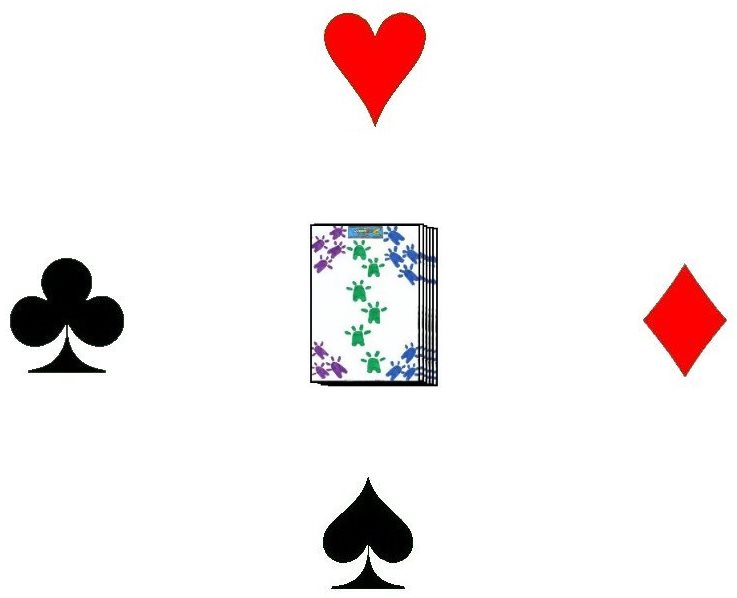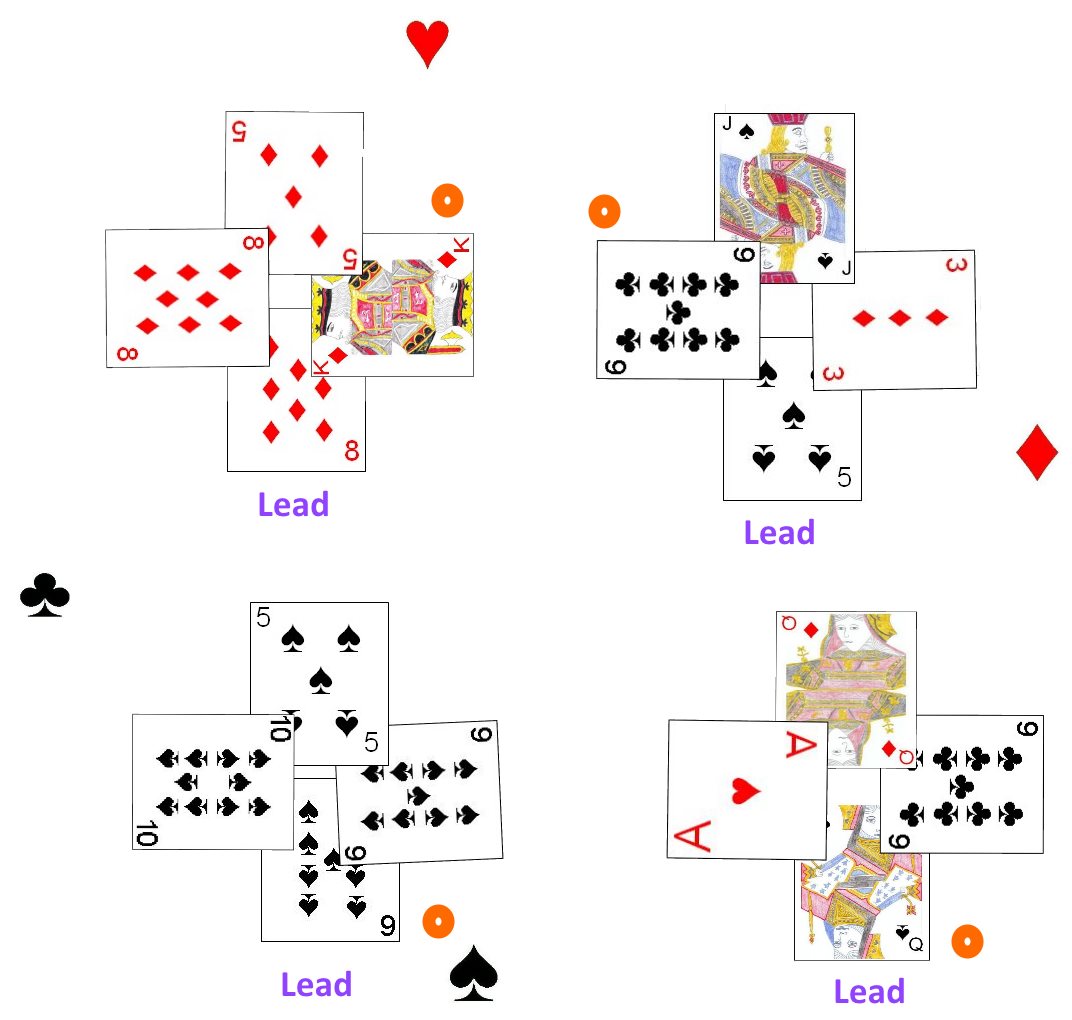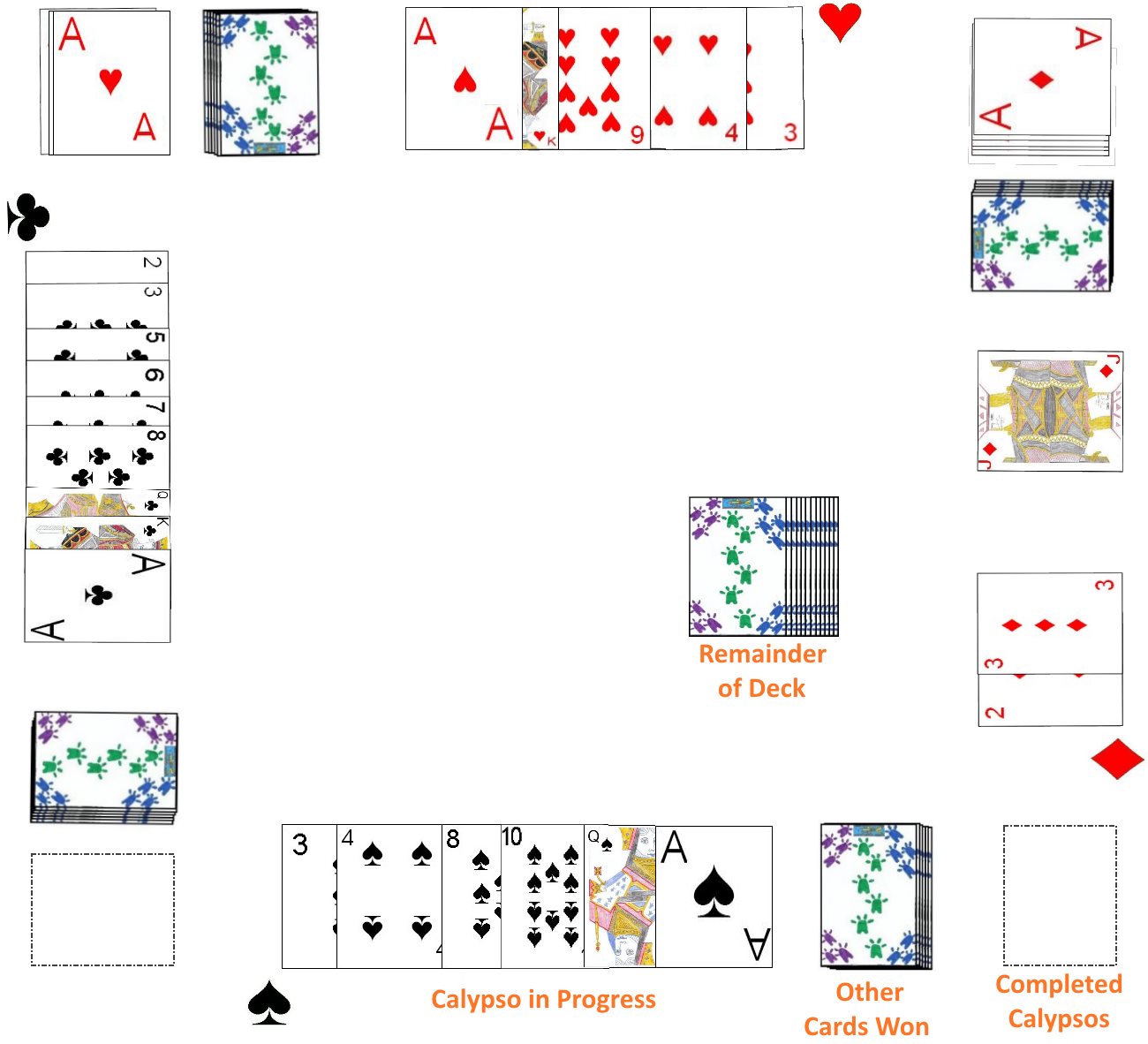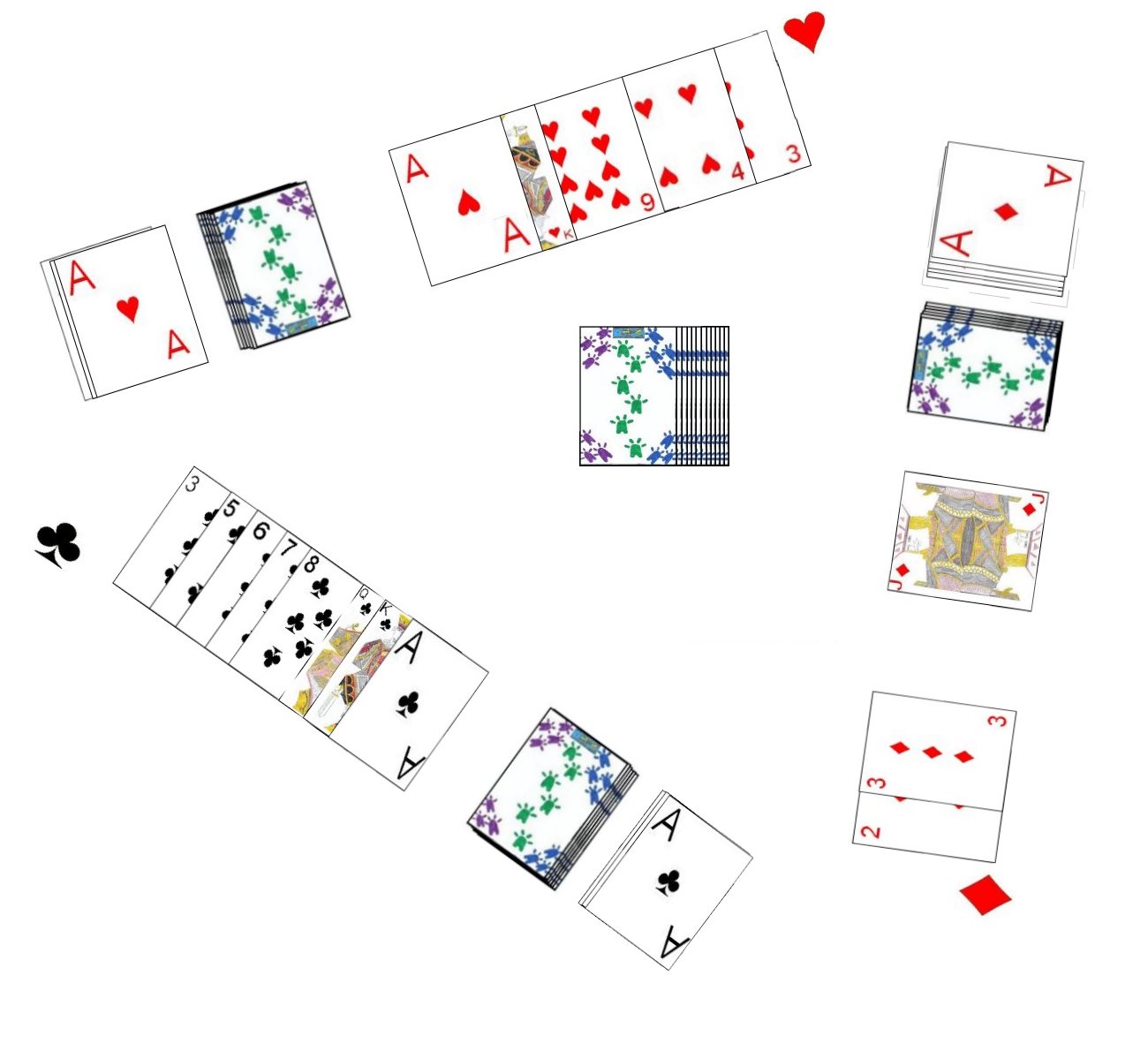 Calypso is designed to be played by four players in two partnerships, although non-partnership versions and variants for 2 and 3 players are described in the Variations section on this page. The game uses a large deck consisting of four standard 52 card decks all shuffled together (making a deck consisting of 208 total cards to be used for the game). For uniformity in play, these decks should all be the same size, style, and back design. The ranking of the cards found in this large deck is as follows (from highest to lowest); Ace, King, Queen, Jack, 10, 9, 8, 7, 6, 5, 4, 3, 2.
Calypso is designed to be played by four players in two partnerships, although non-partnership versions and variants for 2 and 3 players are described in the Variations section on this page. The game uses a large deck consisting of four standard 52 card decks all shuffled together (making a deck consisting of 208 total cards to be used for the game). For uniformity in play, these decks should all be the same size, style, and back design. The ranking of the cards found in this large deck is as follows (from highest to lowest); Ace, King, Queen, Jack, 10, 9, 8, 7, 6, 5, 4, 3, 2.
Determination of partnerships can be done in a variety of ways, with drawing from a shuffled deck a common method. When using this method, the players drawing the two highest cards would play as a partnership against another partnership consisting of the two players drawing the two lowest cards. The partners should each sit directly across from his partner at the table. The player who drew the highest card of all is designated as the first dealer. If two or more players draw cards of the same denomination, those players should then draw another card from the deck. If these new cards are also tied with any other player or players, they should again draw until every player has a card of a unique denomination.
One special feature of Calypso is that each player has his own unique trump suit for the game, different from each other player. Thus, the dealer usually has first choice of selection of his personal trump suit. He may thus select Spades, Clubs, Hearts, or Diamonds as his trump suit for the game. It is customary for the partner of Spades to use Hearts as his trump suit, and the partner of Clubs to have Diamonds as his own personal trump suit. Thus, the dealer would choose his personal trump suit and one member of the opposing partnership (usually the player drawing the higher card in the original draw of thsoe two players) would select from either Clubs or Diamonds, with his partner receiving the suit not thus selected.
Once the players are seated, first dealer determined and trump suits set, the entire large deck should be thoroughly shuffled by the dealer. He then offers the deck to the player at his right to cut. After the cut he then begins the deal. The deal begins with the player to the dealer's immediate left receiving the first card and the dealer continuing to deal the cards one-by-one and face-down in a clockwise rotation around the table. He continues in this manner until each player has thirteen total cards. He then places the remainder of the deck to the side to be used later in the game. The hand is then played out in a series of tricks, with players attempting to win tricks needed to capture special combinations of cards called Calypsos.
 The player to the dealer's immediate left leads the first card to the first trick. Each player must play a card of the same suit led to the trick if they have one. If not, they may play any card from their hand, including one of their personal trump suit. Since each player has his own trump suit for the game, the rules for which card will win a specific trick can be somewhat confusing at first, however after playing several games it can become second nature. The following details the rules for the winning of tricks:
The player to the dealer's immediate left leads the first card to the first trick. Each player must play a card of the same suit led to the trick if they have one. If not, they may play any card from their hand, including one of their personal trump suit. Since each player has his own trump suit for the game, the rules for which card will win a specific trick can be somewhat confusing at first, however after playing several games it can become second nature. The following details the rules for the winning of tricks:
- If the leading player to a trick plays a card of his own personal trump suit, and everyone else plays a card of that same suit, the leading player automatically wins the trick regardless of whether his card was the highest card of that suit played to the trick.
- If the leading player plays a card to the trick of his own personal trump suit and one or more other players is unable to follow suit, they may play a card of any other suit. If any of these players elects to play a card of their own personal trump suit, the highest card played to the trick of a player's own personal trump suit wins the trick. In other words, for each player playing a card of his personal trump suit, the player who played the highest card of his own personal trump suit (including the lead player) wins that trick. If all other players who were unable to play a card of the same suit do not play a card of the led personal trump suit or his own personal trump suit, the lead player still wins the trick.
- If the lead player plays a card other than of his personal trump suit, the highest card played of that suit originally led wins the trick. If the highest card of that suit played to the trick is tied with one or more cards of the same rank and suit, the first of these tied cards is considered to have won the trick. However, if any cards of another player's personal trump suit is instead played to the trick, the highest card of a players personal trump suit played to the trick wins it. For instance, if the lead player does not play a card of his own personal trump suit to the trick, but other players do play a card from their own personal trump suit, the highest card played of a player's personal trump suit wins that trick.
 After winning a trick, the player who won the trick then takes the trick and sorts through the trick to find any cards he needs in creating a Calypso. A Calypso is a full sequence (from two to Ace) of cards of the players personal trump suit. Any cards from that trick that he needs to add to his current Calypso in progress he removes from the trick and adds to his current calypso.
The cards to form this Calypso can be added to the Calypso in any order. Similarly, any cards that his partner can use in helping build his own current Calypso he passes to his partner across the table. Any cards of his own personal suit that he already has as part of his current Calypso as well as any cards that his partner
cannot immediately use in the formation of a Calypso must be aside. Any cards of the opponent partnership's personal trump suits are also set aside. All cards set aside by a player are placed face down in that player's own discard pile. If a player manages to complete a full Calypso upon winning of a trick, he sets it face up to the side in a pile for later scoring. Each completed Calypso of his own suit he manages to gather are added to the same pile. Any cards in that trick which he could use to start a new Calypso can be used to begin his next Calypso. Similarly, if his partner is able to complete a Calypso with cards passed to him from the trick, he may use any additional cards of his own personal trump suit to start a new Calypso.
After winning a trick, the player who won the trick then takes the trick and sorts through the trick to find any cards he needs in creating a Calypso. A Calypso is a full sequence (from two to Ace) of cards of the players personal trump suit. Any cards from that trick that he needs to add to his current Calypso in progress he removes from the trick and adds to his current calypso.
The cards to form this Calypso can be added to the Calypso in any order. Similarly, any cards that his partner can use in helping build his own current Calypso he passes to his partner across the table. Any cards of his own personal suit that he already has as part of his current Calypso as well as any cards that his partner
cannot immediately use in the formation of a Calypso must be aside. Any cards of the opponent partnership's personal trump suits are also set aside. All cards set aside by a player are placed face down in that player's own discard pile. If a player manages to complete a full Calypso upon winning of a trick, he sets it face up to the side in a pile for later scoring. Each completed Calypso of his own suit he manages to gather are added to the same pile. Any cards in that trick which he could use to start a new Calypso can be used to begin his next Calypso. Similarly, if his partner is able to complete a Calypso with cards passed to him from the trick, he may use any additional cards of his own personal trump suit to start a new Calypso.
Once all 13 cards of the hand have been played to tricks and won, the next dealer in turn takes the remainder of the deck and deals 13 more cards to each player. The game then continues in the same manner with each player playing to a trick, with the player to the current dealer's immediate left playing the first card to the first trick of the new deal. Each player retains any completed Calypsos he has set aside as well as Calypsos he is working on between these deals. This continues for a total of four deals (with each player dealing exactly one time). After all cards in the fourth and last hand have been played, the scoring for the hand begins. The following table shows the scoring possibilities in this game:
| Scoring Criteria | Description | Scoring Value |
|---|---|---|
| One Calypso | For a player who manages to create exactly one Calypso during the game | 500 |
| Two Calypsos | For a player who manages to create exactly two Calypsos during the game | 1250 |
| Three Calypsos | For a player who manages to create exactly three Calypsos during the game | 2250 |
| Four Calypsos | For a player who manages to score exactly four Calypsos during the hand. | 3250 |
| Uncompleted Calypso | For each card a player has in an incomplete Calypso | 20 per card |
| Unmelded Cards | For each other card won in tricks not used as part of a Calypso | 10 per card |
The totals of both players are then added together to determine the final score for the partnership for the game. If a player revokes (fails to follow suit when able) his partnership is penalized by allowing the opposing partnership to add 260 points to their own score per occurrence.
After all scores have been calculated, the partnership with the higher score is declared the winners of the game.
